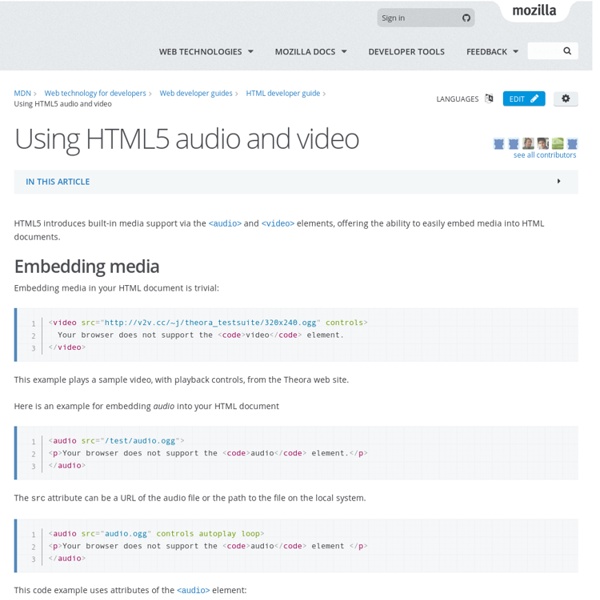Using HTML5 audio and video - Web developer guide

Buzz, a Javascript HTML5 Audio library
Hello Backbone.js Tutorial
Shameless advertisement: Don't forget to check out Agility.js, a simpler alternative to Backbone.js. Hello Backbone is a simple Backbone.js tutorial comprised of self-explanatory "hello world" examples of increasing complexity. It was designed to provide a smoother transition from zero to the popular Todos example. Backbone.js offers a lean MVC framework for organizing your Javascript application. The tutorial starts with a minimalist View object, and progressively introduces event binding/handling, Models, and Collections. Start the tutorial Once in the tutorial, use the navigation menu in the top-right corner to view other examples. Copyright © Artur Adib [ arturadib.com ]
SoundJS | A Javascript library that lets you easily work with HTML5 audio.
Recent Updates Follow @CreateJS December 2013 SoundJS 0.5.2 available. November 2013 SoundJS 0.5.1 available, which addresses webaudio issues introduced in FF25 September 2013 SoundJS 0.5.0 available.HTMLAudioPlugin - fixed an issue with not removing tags from DOM when removing src from SoundJS using removeAllSounds etcDate: April 10th The Story Why we built SoundJS About SoundJS Consistant cross-browser support for audio is currently a mess in HTML5, but SoundJS works to abstract away the problems and makes adding sound to your games or rich experiences much easier.
HTML5 Audio
Javascript Mistakes You Must Avoid
If you are new to JavaScript and you write raw JavaScript or use any framework (jQuery, Mootools, Dojo, YUI) with it, you must avoid few mistakes. Actually these are my experiences when I was learning JavaScript. Equality Operator You may know that in js, two operators are used for comparing values. Here are more examples. Some of the results are unexpected specially for those who don’t know how JavaScript evaluates == operator. Consider the first example (1 == “1″). In the second example (“true” == true) is false because if the string contain characters other than digits, convertion to number will return NaN which means Not a Number. You can check what value will be returned after conversion to number using the Number constructor. Now you maybe wondering how === operator works. Not Assigning null to Reference Types It’s common mistake that many js developers don’t assign null value to variables of reference types (object or Array) when there use is finished. Don’t Forget Keyword var
html5 - 2D Engines for Javascript
Front End Development Guidelines
Accessibility What's Up, DOCTYPE? The absence of a DOCTYPE is a crime punishable by death. You may have relied on the following DOCTYPE in the past, but it's important to know that this is now being superseded by a leaner and meaner snippet. Ideally, the HTML5 DOCTYPE should be used. It's supported in all modern browsers, and throws IE6 and IE7 into standards mode. Write Valid Semantic Markup Writing websites with clean, semantic HTML is something we wish we could always do. Headings should be heirarchically created from <h2>onwards, paragraphs should always be in <p> tags and so on and so forth. Which do you think looks cleaner, this? <span class="sectionHeading">A Heading</span><br /><br /> Lorem ipsum dolor sit amet. ... Or this? <h2>A Heading</h2><p> Lorem ipsum dolor sit amet. ... Fallbacks for Middle Mouse Clicks One of the most frustrating accessibility and usability flaws of the modern web stems from the remapping of hyperlink click functions. Use Microformats Images Need ‘Alt’ Text
Box2DJS - Physics Engine for JavaScript
Related:
Related:



